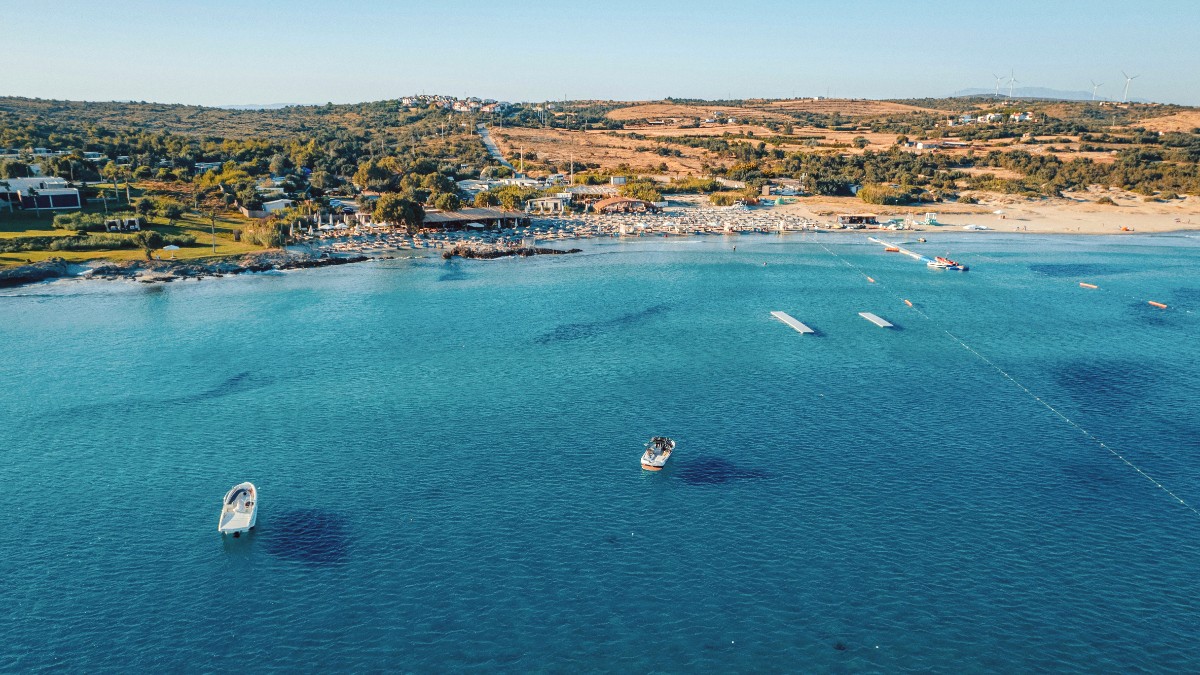
Aegean Coast, Turkey
This peninsula destination, a short distance from the bustling city of Izmir, is an unique blend of historical depth and contemporary holiday excitement. Çeşme promises a journey filled with sensory delights and lasting memories, a true escape from the everyday. This guide shares information to make your visit smooth and truly enjoyable.
Çeşme occupies a prominent position on the westernmost tip of the Çeşme Peninsula, which juts into the Aegean Sea. This geographic placement brings extensive coastline, numerous bays, and breathtaking sea views. To its east lies the vast Izmir Province, linking Çeşme to Turkey's third-largest city, Izmir, by a modern motorway. Westward, across a narrow strait, lies the Greek island of Chios, a visible neighbor that speaks to the region's historical and cultural crosscurrents.
The peninsula itself displays gently rolling hills, olive groves, and a Mediterranean landscape. Its coastline shows variety, featuring long stretches of fine sand beaches, like Ilıca and Boyalık, as well as more sheltered coves like Ayayorgi Bay. Prevailing northerly winds during summer make the area, specifically the nearby town of Alaçatı, a world-renowned spot for windsurfing and kitesurfing. This location and natural beauty make Çeşme a highly sought-after destination, with serene natural escapes and lively coastal experiences. The diverse geography ensures a variety of activities, from relaxing on pristine sands to exploring rugged, scenic viewpoints. The proximity to various natural and cultural sites within the Aegean region means your trip can include more than just beach time.
Çeşme's roots reach back to antiquity, with the ancient Ionian city of Erythrai, one of the twelve Ionian cities, located just a short distance north. Erythrai, established around the 7th century BC, was a significant center for trade and culture. You can still visit its ruins near the village of Ildırı, exploring the remnants of its acropolis, theater, and temple foundations, which tell stories of a bygone era.
The town of Çeşme itself gained prominence during the Ottoman period. Its most visible historical monument, Çeşme Castle, dates back to 1508. This imposing fortress, built by the Ottomans, guarded the port and played an important role in the region's maritime defense. The castle witnessed a pivotal moment in naval history: the Battle of Çeşme in 1770. During this conflict, part of the Russo-Turkish War, the Russian fleet decisively defeated the Ottoman navy in the bay, a battle that had far-reaching consequences for the balance of power in the Aegean. Today, the castle houses the Çeşme Museum, displaying artifacts from Erythrai and items related to the naval battle, providing a tangible connection to the past.
Ionian city, 7th century BC, significant trade & culture center.
Built 1508, Ottoman fortress, port protection.
Russian victory over Ottoman navy.
Artifacts from Erythrai and naval battle items.
Greek and Ottoman influences in old town & Alaçatı.
Throughout the centuries, Çeşme remained an important port, serving as a gateway for trade and cultural exchange between Anatolia and the Aegean islands. Its natural springs, from which the town gets its name ("Çeşme" means "fountain" in Turkish), also added to its historical identity as a refreshing stopover. The architectural styles visible in the older parts of Çeşme town and especially in Alaçatı, with its distinctive stone houses, mirror this layered history, showing influences from Greek and Ottoman periods. These historical layers give Çeşme a depth that goes beyond its reputation as a modern resort, inviting visitors to uncover stories from ancient civilizations and powerful empires.
The region excels in Aegean cuisine, known for its fresh seafood, abundant use of olive oil, and wild herbs. Do not miss local specialties like Kumru (a unique sandwich) and various artichoke dishes. Traditional Turkish breakfasts are a feast for the senses.
Izmir Adnan Menderes Airport (ADB) serves as the main gateway, with direct transfers to Çeşme. Ferry services also link Çeşme to the Greek island of Chios, presenting opportunities for international day trips.
Çeşme delivers a well-rounded travel experience, combining the allure of the sea with cultural richness and lively entertainment. It truly holds something for every type of traveler.
Çeşme presents a compelling picture for any traveler seeking a blend of relaxation, adventure, and cultural flavor. Here is a quick look at what defines this Aegean gem:
Beach clubs transform into open-air dance venues, and numerous bars hold live music and a lively social atmosphere.
Çeşme offers some of Turkey's finest sandy beaches, including Ilıca with its warm thermal waters, and the windy Pırlanta Beach, a paradise for windsurfing and kitesurfing. The crystal-clear Aegean Sea invites swimming, snorkeling, and boat tours to secluded coves and nearby islands.
The region excels in Aegean cuisine, known for its fresh seafood, abundant use of olive oil, and wild herbs. Do not miss local specialties like Kumru (a unique sandwich) and various artichoke dishes. Traditional Turkish breakfasts are a feast for the senses.
Explore the ancient ruins of Erythrai, a significant Ionian city, or step back in time at Çeşme Castle, which houses a museum detailing its past. The architecture in Alaçatı displays the region's Ottoman and Greek influences.
Izmir Adnan Menderes Airport (ADB) serves as the main gateway, with direct transfers to Çeşme. Ferry services also link Çeşme to the Greek island of Chios, presenting opportunities for international day trips.